Investors Can't Miss What's Ahead in Tech 2011
Stock-Markets / Investing 2011 Jan 17, 2011 - 05:54 AM GMTBy: Money_Morning
 Jon D. Markman writes:
Stocks rose gently but purposefully over the past week as investors collectively remembered that negative recent headlines on Portugal, China and Australia were only bound to push more money toward the United States, not force people back into the bomb shelter of government bonds.
Jon D. Markman writes:
Stocks rose gently but purposefully over the past week as investors collectively remembered that negative recent headlines on Portugal, China and Australia were only bound to push more money toward the United States, not force people back into the bomb shelter of government bonds.
It was monkey see, monkey-do: The Dow Jones Industrial Average, Standard & Poor's 500 Index, Nasdaq Composite and Russell 2000 Index all rose by around 1%. Breadth favored decliners by a slim 3-2 margin over advancers, and there were 755 new highs vs. 221 new lows. The new low figure was the highest in awhile, and reflected the decline of the many municipal bond closed end funds. Financials and energy rose the most, while gold and utilities fell the most.
Intel Corp. (Nasdaq: INTC) earnings were the most important news story of the week even if the chip giant's stock did not reflect it. The tech bellwether beat earnings expectations with a record amount of income, and also guided investors to expect revenue in the first quarter of 2011 to come in at $11.1 billion to $11.9 billion, which was much more than the $10.74 billion consensus expectation. The impressive guidance did a lot more for its partners in the semiconductor equipment business, as Applied Materials Inc. (Nasdaq: AMAT) and Novellus Systems Inc. (Nasdaq: NVLS) soared by 7% to 12%.
Semiconductors are now the standout group of the year, as the SPDR Semiconductor ETF
(NYSE: XSD) is up 11%. This has been great for my subscribers, who have owned XSD for two months, but it's also good for everyone who would like to see tech overall succeed over the next year.
I hate to sound like a geezer but if you were not trading in the 1990s you may not have ever experienced the incredible feeling of investing in the chip and chip-equipment companies when they are on a roll. The power and speed and persistence of this group can be mesmerizing and awe-inspiring, and I hope that you will all have an opportunity to experience it in coming months.
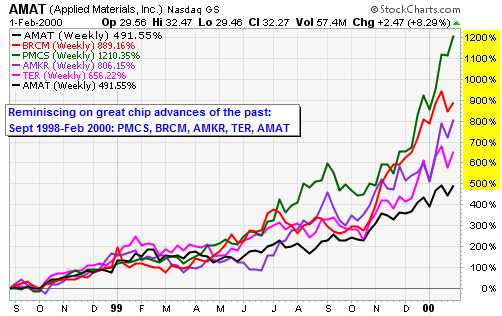
Quick anecdote. Back in the late summer of 1998, CNBC asked me to put together a list of stocks for people to own for the rest of the year. They had a slow Labor Day weekend to fill, and for an hour they showed my stocks with a different panel of commentators every ten minutes. The market had experienced a lousy period with the Asian contagion in 1997 and the Russian ruble default in August 1998, and the mood was as blue as it got for the go-go '90s.
My model loved the semiconductors that week, as it does now, and about a third of my 100 picks were in the chip and chip-equipment space. I felt a little chagrined, as you never really know if it's going to work out, but those names absolutely exploded over the next year and a half, as you can see in the chart above.
Now keep in mind that these were not the profit-challenged dot-coms like Webvan and Exodus or the fraud-tainted software makers like MicroStrategy Inc. (Nasdaq: MSTR). These were mature, profitable industrial companies that were selling engineered equipment and parts into the first big wave of the great broadband, enterprise network and personal computer build-out.
To be sure, valuations ultimately overshot and gave the era a bad reputation for naive investors who didn't know how to grab a chair when the music stopped. But the point is that you wanted to be part of that bubble while it was blowing. And if a new bubble is in the early stages of staging now, I do think you are going to want to be part of it.
Fund managers and individuals are very underinvested in this space, and as you can see in the Intel numbers Thursday night and many more to come, enterprises and people have shown a willingness to spend an increasing portion of their cash on communications, entertainment and productivity services because they satisfy a deep-seated human desire to interact dynamically across distances.
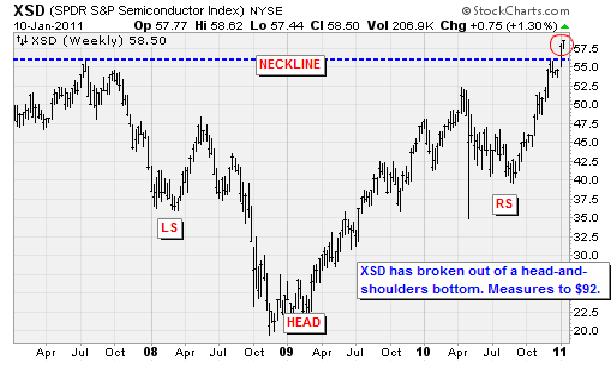
Looking a little more broadly, here is a chart that I showed to my Strategic Advantage subscribers on Jan. 10. It shows an inverse head-and-shoulders bottom forming in the semiconductors fund. Breakouts from this kind of pattern can be extremely powerful.
In less technical language, the index representing all chip stocks appears to have set a firm low in 2009, and recent trading has put in position to scramble out of these depths and start to make real progress on its 2000 highs, which are still more than three times above current levels.
As you can see in the chart, the left shoulder was set in early 2008, the head was set at the start of 2009, and the right shoulder was set in July 2010. The neckline was touched in early December last year and then surpassed last week. And the Jan. 10 action, marked by the red circle, confirmed the breakout on high volume, which is just what the doctor ordered.
Now comes some middle-school geometry. Remember that technical analysts believe they can determine the minimum scope of the next move higher by subtracting the value of the head from the value of the neckline, and adding that amount to the neckline. In other words, they believe the next advance should go at least as high as the prior move went low. In this case the relevant figures are roughly $56 minus $20, equals $36. Add $36 to $56 and you get $92. This is "rule of thumb" territory, nothing scientific, but it gives you a sense of potential magnitude. That's 64% higher than the current quote, as a minimum.
The attention paid to these major tech companies recently helps to validate my theory that chips are the most essential commodity of the new mobile communications age -- the digital bridge between individuals and their objects. Software tells the chips what to do but increasingly semiconductor manufacturers are embedding the most important logic right inside their silicon.
The most vivid example of this change in approach came last year when chip giant Intel bought security software maker McAfee Inc.(NYSE: MFE), which seemed ludicrous at first. But gradually investors have come to recognize that the next stage of technology is one in which the chips have increasing amounts of intelligence burned into their wafers, a process that is helping to create the amazing new world of iPhone, Android and tablet devices.
The closer the instructions are to the brains, the less power is consumed and the faster the processes are carried out. This is why our brains are in our heads and not in our feet, just to throw out a glib comparison. The closer that our information-processing eyes are to the cerebral cortex, the faster their data can be perceived, digested and acted upon.
It's more than brains, though: It's also tactical, or feel. Companies like Atmel Corp.(Nasdaq: ATML) and Cypress Semiconductor Corp.(Nasdaq: CY) make chips that control the cool "multi-touch" screens of smartphones that give them life.
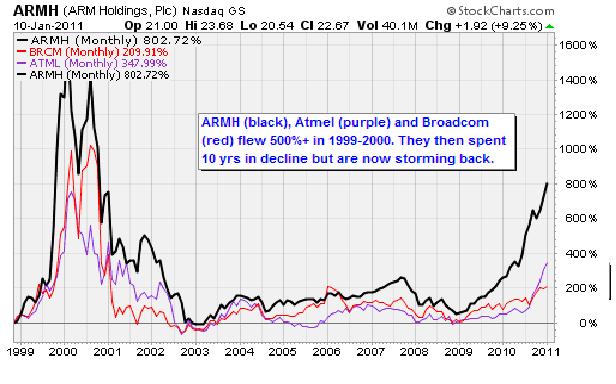
In recent days, the fundamental consolidation and conciliation among chip makers has come fast and furious. Last week, wireless chip giant Qualcomm Inc.(Nasdaq: QCOM) made a bid for smaller rival Atheros Communications Inc.(Nasdaq: ATHR), sending both of those stocks much higher -- as well as the shares of Cavium Networks Inc.(Nasdaq: CAVM), which has been one of my top picks. The feeling is that Cavium would likewise make a nice acquisition for another major in the industry, like Texas Instruments Inc.(NYSE: TXN) or Intel.
Also last week, we learned that Microsoft Corp.(Nasdaq: MSFT) had finally decided to join with every other maker of mobile phone software and develop devices to run on ARM Holdings Plc(Nasdaq ADR: ARMH) silicon. ARMH is a London-based company that sells the intellectual property at the foundation of low-power, high-intensity mobile communications. Its products are at the core of mobile operating systems made by Apple Inc.(Nasdaq: AAPL) and Google Inc.(Nasdaq: GOOG).
Then early last week, two bitter rivals, Intel and NVIDIA Corp.(Nasdaq: NVDA) kissed and made up, with Intel promising to license the smaller firm's graphic chipsets after disputing that for years. And late Monday we learned that the board of Advanced Micro Devices Inc.(NYSE: AMD) was unhappy with the pace of change at the pesky, innovative Intel rival, and had asked its chief exec to leave.
"This is a big inflection point in the marketplace," said Chris Caso, a semiconductor analyst with Susquehanna Financial Group, to an Associated Press reporter on Monday. "And as we look back a couple years from now, the landscape ... is going to change dramatically."
This is change you can believe in as an investor. Make sure that the SPDR Semiconductor fund is an important part of your portfolio. You can add to current positions now, as well as on dips, building to at least a 10% to 15% level in your overall portfolio.
Why buy now even though the group has already broken out? When an ETF breaks out of an inverse head-and-shoulders bottom, there has to have been a lot of recent strength in the move to get to that point, and you might think that's all there is. But this is when a lot of formerly skeptical money starts to come in, and it's not late. The motto for these moments: "Don't hate me because I'm beautiful.''
Here's an example: NVIDIA, long known as a graphic chip maker, wowed the crowd at the Consumer Electronics Show in Las Vegas with its new Tegra offering, which powered new Android phones that showed blinding speed equivalent to the fastest consumer desktops. Attention has also come due to a stunning new deal in which arch-rival Intel agreed to license its technology. The scale of these two things is very different but let me just note that the 1,000% move that wireless chip pioneer Qualcomm logged in 1999 began early that year when Nokia Corp.(NYSE ADR: NOK) settled a long feud by licensing its technology.
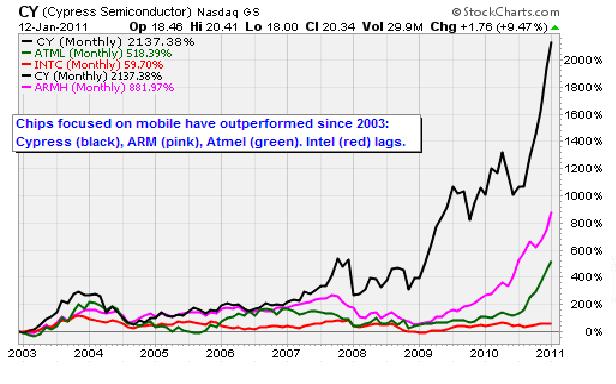
Let's stop a moment and recognize again how important the wireless business has become to all of the semiconductor makers. A dozen years ago they were mostly focused on making personal computers, corporate networks and fiber optic metro nets run faster, more reliably and cheaper. Most were valued to the moon by 2000 and then crashed to earth and spend an eight-year period with their shares mostly flat with a downward bias.
All that time, though they were jostling for an opportunity to build parts for the new new thing but the industry and the public could not decide what that was. It was not until the iPhone was introduced in 2007 that chip makers finally began to recognize where their next big moment would come, and now they are competing like crazy again to one-up each other with amazing products for the mobile Internet.
This not happening without context. It is happening because 91% of Americans have jobs, wages are slowly rising, and people are finding more joy in the little things in life that used to be much more expensive and difficult to discover.
Think about how you used to spend your daydream or procrastination time a decade ago vs. how you spend it now. I was just commenting to a friend about the fact that back in the 1990s we techie types used to lust after the branded new PC models that would come out at this time of year. We wanted more CPU power, more RAM, bigger monitors, more hard disk space.
And now? I rarely think about my PC anymore. It's a custom-built, no-name model built on an AMD chip that I have owned for two years, it works great and I have no plans to replace it with anything faster or bigger. The box is in a cabinet under my desk, so who cares what the label says. Now all of our tech lust is focused on the mobile Internet. We scour sites like Gizmodo.com and Endgadget.com and marvel at the new handsets that are coming out based on the latest ARM and NVIDIA cores and given life by Atmel and Cypresstouchscreen controllers.. And when it comes time to procrastinate, we might turn to Angry Birds on the Apple iPad, which is an amazing "casual" game, as they say in the industry -- easy to pick up, enjoy for 15 minutes, and put down (if you can).
Here's how much our ''non-work'' work world is changing: Rovio, the Finnish maker of Angry Birds, claims that people spend 200 million minutes a day playing their game worldwide. It has been the No. 1 paid game for iPad and iPhone for the past year, at 99 cents each download. That is a mind-boggling number if true, and all that time and mindshare is coming away from television and radio, not to mention books and magazines.
Advertisers will pay heed, and the world of entertainment will never be the same. But more importantly for technology, device and chip makers will orient themselves to build devices to satisfy our growing dependence on handhelds. This is an accelerating trend, and we are still near the start.
So keep your eyes on SPDR Semiconductor because these companies are at the center of social, cultural and financial trends. They represent a redirected stream of time and money -- they're not just price points on a chart. And their shares are going to help us build wealth at the same time.
Bottom line: The chips are back. You need to own them.
IPhone and Portugal, Really?
One of the major news points this week was an announcement by Verizon Communications Inc. (NYSE: VZ) that it planned to sell the iPhone from Applefor the first time. You would have thought that this was an announcement of a cure for cancer or a breakthrough on teleportation.
You have to admit it's a drowsy week when it's highlighted by a telephone carrier's decision to carry a particular brand of handheld device. Maybe next week we'll learn that McDonald's Corp. (NYSE: MCD) has switched napkins vendors.
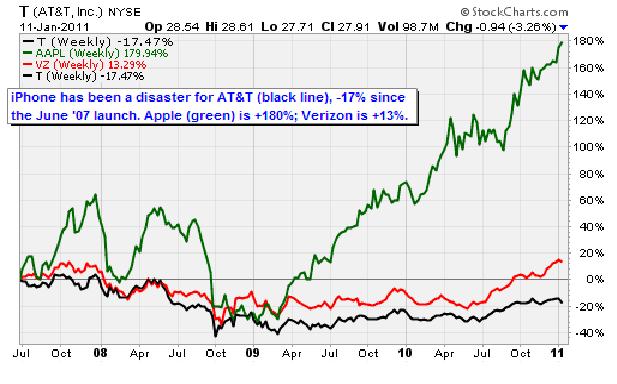
The deal means very little for either Apple or Verizon. People who wanted an iPhone could always get one on AT&T Inc. (NYSE: T) and people who were on Verizon could always buy other mobile devices. Some people say that the Verizon network is better, but this is largely unproven by scientific testing. My expectation is that when subjected to the data demand of iPhone users, the Verizon network will probably perform about the same as AT&T.
They all talk a lot about how each network is different, but most of that is marketing; all of these networks started as the Ma Bell monopoly, broke up into Baby Bells, and then have reconsolidated as Super-Baby Bells. But the underlying network is very similar. Probably the best report on this non-event was produced by The Daily Show, which depicted it as a liberation movement.
Over in Europe the news was just as snoozy as the main focus of attention was on the finances of Portugal, and whether it would need a bailout or not. Really, I mean, Portugal? Portugal?! As they say on ESPN, "C'mon man!"
Remember how the Dubai debt crunch in November 2009 was expected to bring back the global credit crisis? That was a great buying opportunity. Then how about the Greek fiscal crisis? Lot of fire and smoke last year at this time, but no measurable lasting impact on global trading.
Then there was North Korea's artillery bombardment of a South Korean island in the fall, and Ireland's fiscal crisis in November. Not to mention China's inflation problem, India's telecom corruption scandal, the Russian drought, the Australian floods or the Indonesian volcanoes. Impact on U.S. equity and credit pricing: Zero, zero, zero, zero, zero and zero. Stack them all up and smack them with a slingshot full of angry birds and it's still zero.
Global markets are just not responding to the crisis button these days. Maybe they will next week or next month, but we have seen repeatedly over the last two years that the markets only care about three or four things: low interest rates, low inflation, the mood of the Federal Reserve and sometimes, when there is nothing else going on, like the announcement of new wallpaper at Verizon offices, signs of improved corporate earnings growth.
In short, equity investors keep tying themselves up in knots worrying about whether the credit market is going to fall apart due to one foreign calamity or another. But the credit market has not shown that it cares in the slightest about any of it. European, U.S. and emerging market government and corporate debt has been well bid through thick and thin, with low-rated debt selling even better than investment grade. In fact, credit buyers appear to have used every dip to buy even more, and with leverage piled high like pastrami and Swiss on rye -- the heart attack special.
My favorite independent debt analyst reports that the credit market is now trading at a level that is the equivalent of the 1,800 level of the S&P 500. Since the credit market tends to lead the equity market by six to fifteen months, he believes that is where stocks are going, though of course it will not be a straight line. Our recommendations for income investors, like American Capital Agency Corp. (Nasdaq: AGNC), have certainly continued to show a lot of spunk despite all the world turmoil. Give credit where credit is due. Stay positive.
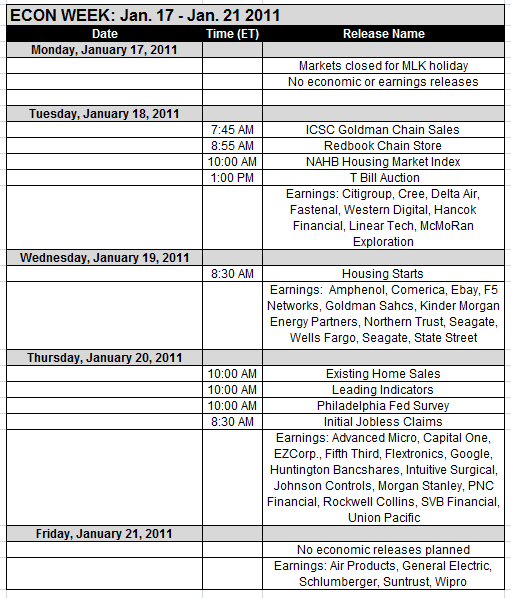
[Editor's Note: Money Morning Contributing Writer Jon D. Markman has a unique view of both the world economy and the global financial markets. With uncertainty the watchword and volatility the norm in today's markets, low-risk/high-profit investments will be tougher than ever to find.
It will take a seasoned guide to uncover those opportunities.
Markman is that guide.
In the face of what's been the toughest market for investors since the Great Depression, it's time to sweep away the uncertainty and eradicate the worry. That's why investors subscribe to Markman's Strategic Advantage newsletter every week: He can see opportunity when other investors are blinded by worry.
Subscribe to Strategic Advantage and hire Markman to be your guide. For more information, please click here.]
Source : http://moneymorning.com/2011/01/16/...
Money Morning/The Money Map Report
©2011 Monument Street Publishing. All Rights Reserved. Protected by copyright laws of the United States and international treaties. Any reproduction, copying, or redistribution (electronic or otherwise, including on the world wide web), of content from this website, in whole or in part, is strictly prohibited without the express written permission of Monument Street Publishing. 105 West Monument Street, Baltimore MD 21201, Email: customerservice@moneymorning.com
Disclaimer: Nothing published by Money Morning should be considered personalized investment advice. Although our employees may answer your general customer service questions, they are not licensed under securities laws to address your particular investment situation. No communication by our employees to you should be deemed as personalized investent advice. We expressly forbid our writers from having a financial interest in any security recommended to our readers. All of our employees and agents must wait 24 hours after on-line publication, or 72 hours after the mailing of printed-only publication prior to following an initial recommendation. Any investments recommended by Money Morning should be made only after consulting with your investment advisor and only after reviewing the prospectus or financial statements of the company.
Money Morning Archive |
© 2005-2022 http://www.MarketOracle.co.uk - The Market Oracle is a FREE Daily Financial Markets Analysis & Forecasting online publication.



